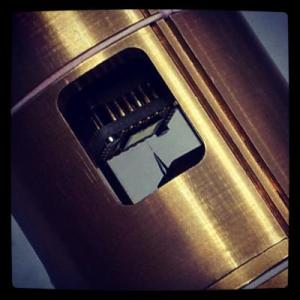Nov 26 2013
Weizmann Institute scientists have taken a quantum leap toward understanding the phenomenon known as superconductivity: They have created the world's smallest SQUID – a device used to measure magnetic fields – which has broken the world record for sensitivity and resolution.
 A section of a scanning probe microscope using the world's smallest SQUID (Superconducting Quantum Interference Device) created to date, probing a sample to measure its magnetic field. This novel instrument may help toward understanding superconductivity and gain insights into novel physics phenomena. Developed by Prof. Eli Zeldov and team of the Weizmann Institute's Condensed Matter Physics Department. Credit: Weizmann Institute of Science
A section of a scanning probe microscope using the world's smallest SQUID (Superconducting Quantum Interference Device) created to date, probing a sample to measure its magnetic field. This novel instrument may help toward understanding superconductivity and gain insights into novel physics phenomena. Developed by Prof. Eli Zeldov and team of the Weizmann Institute's Condensed Matter Physics Department. Credit: Weizmann Institute of Science
Superconductivity is a quantum phenomenon that only occurs when certain materials are cooled to extremely low temperatures. Then, they lose all resistance to the flow of electricity and expel the magnetic fields within them. Although used in everything from MRI scanners to particle accelerators, scientists still do not fully understand the physics that underlies the behavior of superconductors. Among other things, superconducting materials are found in the very SQUIDs used to measure superconducting properties: SQUID stands for Superconducting QUantum Interference Device.
Nano-SQUIDs are placed on probes to scan and measure the magnetic field at different points on a sample, forming an image of the entire surface – a bit like creating a heat map of a hand by measuring its temperature at individual points on the fingers and palms.
Even very sensitive SQUIDS present geometric challenges when it comes to scanning materials: They need to be as small as possible to attain the highest image resolution, and they need to get as close as possible to the sample to image the tiniest magnetic features. Postdoctoral fellows Drs. Yonathan Anahory and Denis Vasyukov, and PhD student Lior Embon, along with their colleagues in the lab of Prof. Eli Zeldov of the Condensed Matter Physics Department, have risen to the challenge – as reported in Nature Nanotechnology – thanks to a unique setup: They took a hollow quartz tube and pulled it into a very sharp point; then succeeded in fabricating a SQUID encircling the tip measuring a mere 46 nm in diameter – the smallest SQUID to date. They then constructed a scanning microscope around the tip – an achievement that enabled them to obtain magnetic images at distances as small as a few nanometers from the sample. Current SQUIDs manufacturing methods limit their size and their ability to get very close to a surface.
"We have the opposite problem: We have to prevent the probe from 'crashing' into the sample," says Embon. "While there are SQUIDs with higher sensitivities to uniform magnetic fields, the combination of high sensitivity, proximity of the probe to the sample and its minute dimensions make the overall accuracy of the device record-breaking." This "nano-SQUID-on-tip" might, in the future, be able to measure the magnetic field from the spin of a single electron – the Holy Grail of magnetic imaging.
According to Zeldov, who is already using the new device to investigate superconductive phenomena in his lab, this invention will hopefully not only lead to a better understanding of superconductivity and vortex flow for the effective application of superconductor technology, but will aid in gaining insights into novel physical phenomena. As a surprising, added bonus, the new SQUID appears to be able to measure many materials other than superconductors.
Prof. Eli Zeldov is the incumbent of the David and Inez Myers Professorial Chair.